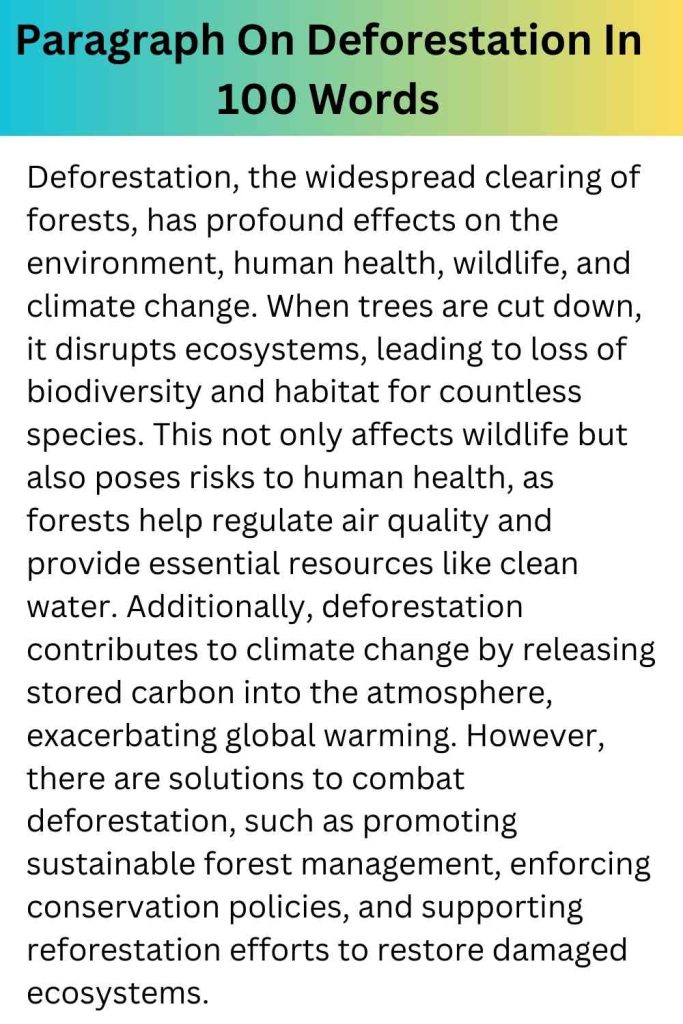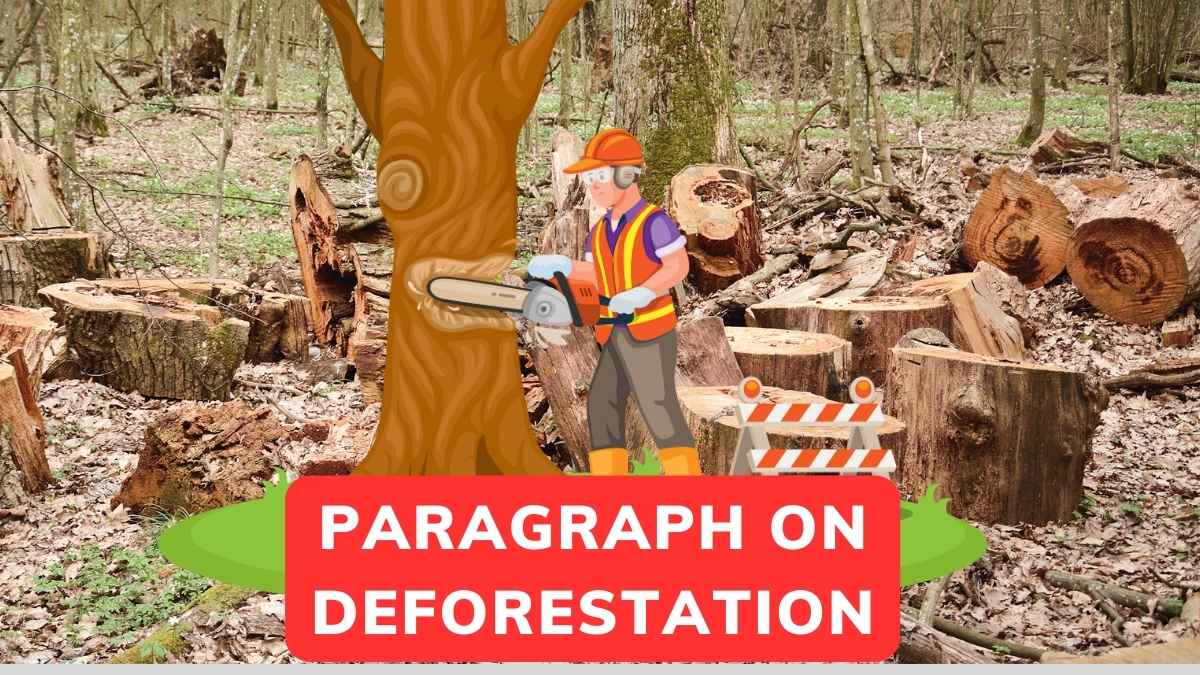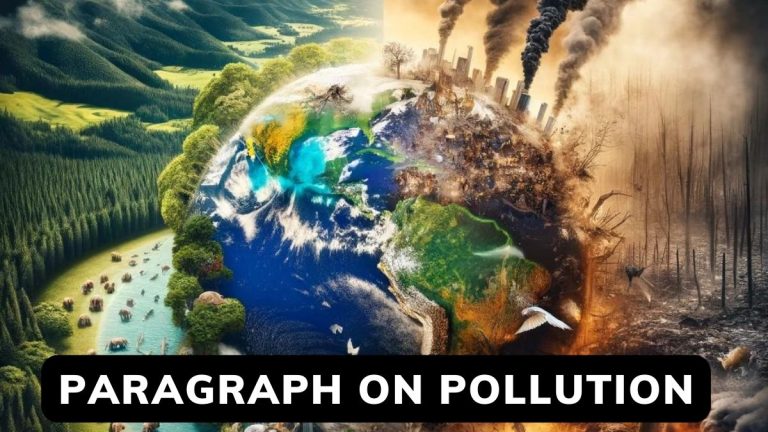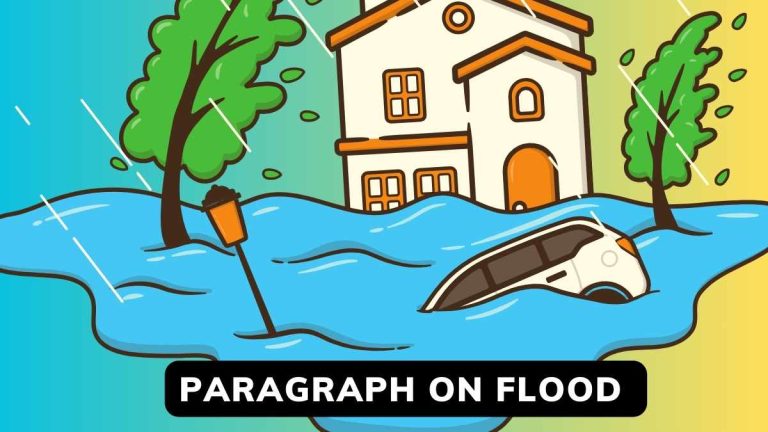Paragraph On Deforestation In English Class 5-12
Paragraph On Deforestation For Class 5
Deforestation is a serious issue that affects our environment in many ways. When trees are cut down, it harms the balance of nature. First, it affects the environment by reducing the number of trees that produce oxygen and clean the air we breathe. This can lead to more pollution and respiratory problems for people. Second, deforestation destroys the homes of many animals, causing them to lose their habitats and sometimes even leading to extinction. Third, it contributes to climate change because trees help absorb carbon dioxide, a greenhouse gas that traps heat in the atmosphere. Finally, deforestation can lead to problems like soil erosion and flooding because trees help hold soil in place and absorb excess water. However, there are solutions to deforestation, such as planting more trees, using recycled paper, and supporting sustainable logging practices. By taking action to protect our forests, we can help preserve the environment for future generations.
Paragraph On Deforestation For Class 6
Deforestation, the cutting down of trees on a large scale, has several significant effects on the environment, wildlife, and even human health. One of the most noticeable impacts is the loss of habitats for animals and plants, leading to a decrease in biodiversity. This can disrupt ecosystems and threaten the survival of many species. Moreover, deforestation contributes to climate change by releasing stored carbon dioxide into the atmosphere, which accelerates global warming. Human health is also affected as deforestation can lead to air and water pollution, soil erosion, and an increase in infectious diseases. To tackle this issue, solutions such as reforestation, sustainable forest management, and stricter policies against illegal logging are essential. By protecting our forests, we can preserve biodiversity, mitigate climate change, and safeguard both the environment and human well-being.
Paragraph On Deforestation For Class 7
Deforestation, the process of cutting down trees on a large scale, has significant impacts on the environment, wildlife, human health, and climate change. Firstly, deforestation harms the environment by reducing biodiversity and disrupting ecosystems. Trees play a crucial role in providing habitat for numerous plant and animal species, and their removal can lead to the loss of these habitats. Secondly, deforestation affects human health by increasing the risk of air and water pollution. The clearing of forests can release harmful pollutants into the air and water, leading to respiratory problems and other health issues for nearby communities. Thirdly, deforestation has a profound impact on wildlife populations. Many species depend on forests for food, shelter, and breeding grounds, and their habitats are destroyed when trees are cut down. Fourthly, deforestation contributes to climate change by releasing carbon dioxide into the atmosphere. Trees absorb carbon dioxide during photosynthesis, so when they are removed, this greenhouse gas is released back into the air, exacerbating global warming. Finally, while deforestation poses significant challenges, there are solutions that can help mitigate its effects. These include reforestation efforts, sustainable forestry practices, and international agreements to protect forests. By taking action to address deforestation, we can protect the environment, wildlife, and human health while combating climate change.
Paragraph On Deforestation For Class 8
Deforestation, the widespread clearing of forests, has significant impacts on our environment, health, wildlife, and climate. Firstly, deforestation disrupts the delicate balance of ecosystems, leading to loss of biodiversity and habitat for countless plant and animal species. This can result in the extinction of species and disrupts the food chain, ultimately affecting human populations as well. Moreover, deforestation contributes to climate change by releasing stored carbon into the atmosphere, which accelerates global warming. This, in turn, leads to extreme weather events, rising sea levels, and disruptions in agricultural patterns, impacting human livelihoods. Additionally, deforestation can have direct health consequences for humans, as it can lead to air and water pollution, increased risk of diseases, and loss of medicinal plants found in forests. However, there are solutions to mitigate deforestation, such as promoting sustainable forest management, enforcing stricter regulations on logging and land use, supporting reforestation efforts, and encouraging the use of alternative materials to wood. By addressing deforestation effectively, we can protect our environment, safeguard human health, preserve wildlife, mitigate climate change, and ensure a sustainable future for generations to come.
Paragraph On Deforestation For Class 9
Deforestation, the widespread clearing of forests, has significant impacts on both the environment and human well-being. One of the primary effects of deforestation is its detrimental impact on the environment. As trees are cut down, vital habitats for countless plant and animal species are destroyed, leading to a loss of biodiversity. This disruption in ecosystems can have cascading effects, leading to the decline or extinction of various species. Moreover, deforestation contributes to soil erosion, disrupts water cycles, and reduces the earth’s ability to absorb carbon dioxide, exacerbating climate change. Additionally, deforestation has adverse effects on human health, as it can lead to increased air pollution, the spread of diseases, and the loss of natural resources essential for sustenance. Furthermore, deforestation impacts wildlife by reducing their habitats, leading to displacement, endangerment, or extinction of species. To combat these challenges, it is essential to implement solutions such as reforestation, sustainable forest management practices, and international agreements to protect forests. By addressing deforestation, we can mitigate its harmful effects on the environment, human health, wildlife, and climate change, ensuring a sustainable future for generations to come.
Paragraph On Deforestation For SSC
Deforestation, the widespread clearing of forests for various purposes such as agriculture, logging, and urbanization, has significant impacts on the environment, human health, wildlife, and climate change. Firstly, it leads to the loss of biodiversity and disrupts ecosystems, affecting the habitats of countless plant and animal species. This loss of habitat threatens the survival of many species and can even lead to their extinction. Secondly, deforestation contributes to air and water pollution, which can have adverse effects on human health, causing respiratory illnesses and waterborne diseases. Additionally, the removal of trees reduces the earth’s capacity to absorb carbon dioxide, a major greenhouse gas, thereby exacerbating climate change. The resulting increase in global temperatures leads to more frequent and severe weather events, such as storms and droughts, further impacting both human populations and natural habitats. To address these issues, solutions such as sustainable forest management, reforestation efforts, and the implementation of policies to curb deforestation are crucial. By protecting and restoring forests, we can mitigate the adverse effects of deforestation and ensure a healthier environment for both humans and wildlife.
Paragraph On Deforestation For HSC
Deforestation, the process of clearing forests for various purposes like agriculture, logging, and urbanization, has significant effects on the environment, human health, wildlife, and climate change. Firstly, it leads to habitat loss and disrupts ecosystems, causing a decline in biodiversity and the extinction of species. Secondly, deforestation contributes to air and water pollution, leading to respiratory problems and waterborne diseases in humans. Moreover, it disrupts the natural habitats of wildlife, forcing them to migrate or face extinction. Additionally, deforestation contributes to climate change by releasing carbon dioxide into the atmosphere, exacerbating global warming and altering weather patterns. However, there are solutions to combat deforestation, such as promoting sustainable forestry practices, enforcing strict laws against illegal logging, and reforestation efforts to restore lost habitats and absorb carbon emissions. By addressing the root causes of deforestation and implementing effective solutions, we can mitigate its harmful effects on the environment, human health, wildlife, and climate change.
Paragraph On Deforestation In 100 Words
Deforestation, the widespread clearing of forests, has profound effects on the environment, human health, wildlife, and climate change. When trees are cut down, it disrupts ecosystems, leading to loss of biodiversity and habitat for countless species. This not only affects wildlife but also poses risks to human health, as forests help regulate air quality and provide essential resources like clean water. Additionally, deforestation contributes to climate change by releasing stored carbon into the atmosphere, exacerbating global warming. However, there are solutions to combat deforestation, such as promoting sustainable forest management, enforcing conservation policies, and supporting reforestation efforts to restore damaged ecosystems.
Paragraph On Deforestation In 100 Words PDF

Paragraph On Deforestation In 150 Words
Deforestation, the widespread clearing of forests for various purposes, has profound effects on the environment, wildlife, human health, and climate change. Firstly, it disrupts ecosystems, leading to loss of biodiversity, soil erosion, and disrupted water cycles. This, in turn, affects wildlife habitats and reduces their population. Secondly, deforestation contributes to air and water pollution, leading to respiratory illnesses and waterborne diseases in humans. Thirdly, it exacerbates climate change by releasing stored carbon dioxide into the atmosphere, contributing to global warming. The loss of trees also diminishes the Earth’s ability to absorb carbon dioxide, further amplifying the greenhouse effect. To combat deforestation, solutions like sustainable forest management, reforestation initiatives, and international agreements to protect forests are crucial. Additionally, promoting alternative sources of income for communities dependent on logging can help alleviate pressure on forests. Overall, addressing deforestation is vital for preserving ecosystems, protecting wildlife, safeguarding human health, and mitigating climate change impacts.
Paragraph On Deforestation In 200 Words
Deforestation, the process of clearing or removing trees from forests or woodlands, has profound effects on our planet. Firstly, it disrupts the delicate balance of ecosystems, leading to loss of biodiversity and habitat destruction for countless plant and animal species. This loss of habitat can drive species to extinction and disrupt entire food chains, affecting wildlife populations worldwide. Moreover, deforestation contributes to climate change by releasing stored carbon dioxide into the atmosphere, a major greenhouse gas that exacerbates global warming. This not only impacts the health of our planet but also poses risks to human health, as increased carbon emissions contribute to air pollution and respiratory illnesses. Additionally, deforestation leads to soil erosion, loss of fertile land, and disruption of water cycles, further impacting agriculture and human livelihoods. However, there are solutions to mitigate the effects of deforestation, such as reforestation efforts, sustainable forest management practices, and international agreements to protect forests. By addressing the root causes of deforestation and promoting conservation efforts, we can work towards a healthier planet for current and future generations.
Paragraph On Deforestation In 250 Words
Deforestation, the widespread clearing of forests for various purposes, has profound effects on the environment, human health, wildlife, and climate change. Firstly, deforestation disrupts ecosystems, leading to loss of biodiversity, soil erosion, and disruption of water cycles. Without trees to absorb carbon dioxide, greenhouse gases accumulate in the atmosphere, exacerbating climate change. Moreover, deforestation contributes to air and water pollution, affecting human health through respiratory problems and waterborne diseases. Wildlife also suffers as their habitats are destroyed, leading to loss of species and disruption of ecological balance. Additionally, deforestation worsens climate change by reducing the earth’s ability to regulate temperature and water cycles. However, there are solutions to mitigate deforestation’s impact. Reforestation efforts aim to replant trees in areas affected by deforestation, restoring habitats and biodiversity. Sustainable forest management practices promote responsible logging and conservation of forests. Furthermore, international agreements and policies, such as the New York Declaration on Forests and the Glasgow Leaders’ Declaration, pledge to end and reverse deforestation by 2030. These efforts highlight the importance of global cooperation in addressing deforestation. Overall, understanding the effects of deforestation on the environment, human health, wildlife, and climate change is crucial for implementing effective solutions and preserving the planet for future generations.
Short Paragraph On Deforestation
Deforestation, the widespread clearing of forests, has significant impacts on the environment, human health, wildlife, and climate change. Environmental effects include soil erosion, loss of biodiversity, and disruption of ecosystems. Human health can be affected by air pollution from burning forests and the loss of natural resources vital for medicine. Wildlife suffers from habitat destruction, leading to population decline and extinction. Climate change is exacerbated as forests act as carbon sinks, absorbing carbon dioxide from the atmosphere. Solutions to deforestation include sustainable forest management, reforestation efforts, and international agreements to protect remaining forests. It’s crucial to address deforestation to preserve the health of our planet and ensure a sustainable future.







